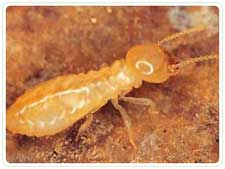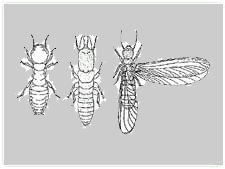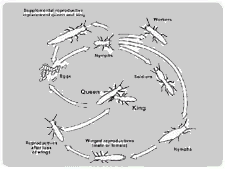Subterranean Termites
P. G. Koehler and C. L. Tucker

Subterranean termites ( Figure 1 ) are the most destructive and frequently encountered kind of termite found throughout the state. Although they nest in soil, subterranean termites can attack structures by building tubes that connect their nest to wood in structures. Aerial nests can occur without a ground connection if all castes of the colony are present and moisture is available.
Biology

Subterranean termites are social insects that live in colonies consisting of many individuals. The colonies are composed of workers, soldiers and reproductives( Figure 2 ). The workers, which are about 1/8 inch long, have no wings, are white to cream colored and very numerous. Soldiers defend the colony against insects, like ants, that can attack the colony. Soldiers are wingless and white in color with large brown heads and mandibles (jaws). King and queen termites perform the reproductive functions of the colony. They are dark brown to black in color and have two pairs of wings about twice the length of their body.
See Figure 3 for the Termite Life Cycle.

Subterranean termites feed on wood or other items that contain cellulose, such as paper, fiberboard, and some fabrics derived from cotton or plant fibers. Termites have protozoa in their digestive tracts that can convert cellulose into usable food.
Subterranean termites nest in the soil to obtain moisture, but they also nest in wood that is often wet. They easily attack any wood in contact with the ground. If the wood does not contact the soil, they can build mud tunnels or tubes to reach wood several feet above the ground. These tunnels can extend for 50-60 feet to reach wood and often enter a structure through expansion joints in concrete slabs or where utilities enter the house.
Detection of Termites

Termites remain hidden within wood and are often difficult to detect. However, subterranean termites may be detected by the presence of winged reproductives, mud tubes, and wood damage.
Winged Reproductives
Winged reproductives ( Figure 4 ) emerge from colonies in great numbers usually in the spring and during the daylight hours. Usually termites are first noticed by the presence of winged reproductives. Mating occurs during these flights, and males and females form new colonies.

Winged termites can be distinguished from flying ants by their thick-waist, straight antennae and wings of equal size. ( Figure 5 )
Large numbers of winged termites in a house are an indication of probable infestation. Termite wings break off shortly after their flight, and even though the actual swarming is not observed, the presence of discarded wings indicate that a colony is nearby. Because termites are attracted to light, their broken-off wings are often near doors or windows where the termites have been attracted to the light.
Winged termites emerging from the ground out-of-doors near the house does not necessarily mean the house is infested, but it is a good reason to check further. Termites in the wood of homes or other buildings usually come from colonies already established in the soil.
Peak swarming periods for subterranean termites are from March through May in Charlotte. They may also swarm to a lesser extent during the other months.
Mud Tubes

Subterranean termites build earthen, shelter tubes to protect them from low humidity and predation ( Figure 6 ). These tubes are usually 1/4 to 1 inch wide. Houses should be inspected at least once a year for evidence of tubes. If the house has a crawl space, the inside and outside of foundations should be inspected for tubes. If the house has a concrete slab floor, cracks in concrete floors and places where pipes and utilities go through the slab should be closely examined. Cracks in concrete foundations and open voids in concrete block foundations are also hidden avenues of entry.

